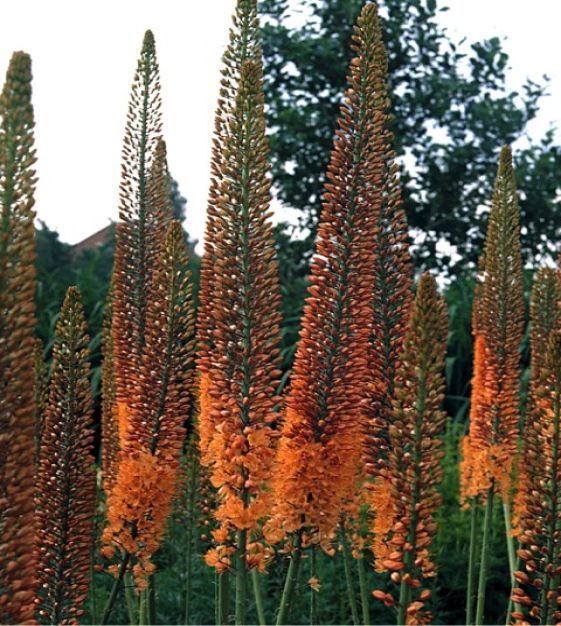-
- Discounted Collections
- Website Specials
- New for 2025!
- Tulips
- Narcissi
- Allium
- Anemone blanda
- Brodiaea
- Camassia
- Chionodoxa
- Corydalis
- Crocus
- Eranthis
- Eremurus
- Erythronium
- Fritillaria
- Galanthus
- Geranium
- Gladiolus
- Hyacinths
- Hyacinthoides
- Ipheion uniflorum
- Dutch Iris
- Rock Garden Iris
- Ixiolirion
- Leucojum aestivum
- Muscari
- Ornithogalum
- Oxalis
- Puschkinia
- Scilla
- Lilies
- Peonies
- Amaryllis
- Paperwhites
- Tender Bulbs
- Anemone Giants
- Tecolote Ranunculus
- Freesias
Eremurus ruiter-Hybrid Cleopatra
It is pale to dark burnt-orange with darker red midribs and chrome yellow stamens. (To make sure that we get Eremurus orders shipped as early as we possibly can, we will now have them flown in from the Netherlands rather than waiting to receive them from a two+ week container ship crossing the Atlantic. Eremurus will arrive here for asap shipment in early to mid-October.)
Imagine this spidery rootstock as your hand with the fingers outstretched. The top of the back of your hand is the nose of the Eremurus and your fingers are its spidery tentacles. Plant immediately in rich, well-draining soil in a dry spot. Plant with the "nose" up and the fingers out: do not break off any of the tentacles and only cover the top of the rootstock with 2" to 3" of soil. In areas with cold winters and inconsistent snow cover, a 2" layer of mulch should be applied after the top of the ground freezes to protect the shallow rootstocks from temperature spikes. Top size tuberous rootstocks. May/June. HZ: 5-8. 3' to 6'.
Eremurus are The Art & Soul of Spring.
Eremurus Horticultural Tips
Imagine this spidery rootstock as your hand with the fingers outstretched. The top of the back of your hand is the nose of the Eremurus and your fingers are its spidery tentacles. Plant immediately in rich, well-draining soil in a dry spot. Plant with the "nose" up and the fingers out: do not break off any of the tentacles and only cover the top of the rootstock with 2" to 3" of soil. In areas with cold winters and inconsistent snow cover, a 2" layer of mulch should be applied after the top of the ground freezes to protect the shallow rootstocks from temperature spikes. Top size tuberous rootstocks. May/June. HZ: 5-8. 3' to 6'.
Eremurus are The Art & Soul of Spring.
Eremurus Horticultural Tips
- Information
Eremurus
Commonly known as Desert Candles or Foxtail Lilies, these tall willowy spires are comprised of densely-packed flowers that open progressively from the bottom of each spike up, with a sparse, ground-level rosette of long strappy leaves. Deer-and rodent-resistant, Eremurus prefers rich, well-draining soil in a dry spot with bright sunlight and protection from wind. Not a bulb, but a spider-like, woody tuberous rootstock, Eremurus do not like being out of the soil, so plant immediately upon receipt. The rootstocks dry out after harvest and rehydrate once planted.
Loosen the soil at each individual planting site: 36” apart (never overcrowd them). Imagine the rootstock as your hand with the fingers outstretched. The top of the back of your hand is the “nose” or the pointed crown of the Eremurus, and your fingers are its spidery tentacles. Gently place each brittle, spidery rootstock with its pointed crown facing up and the fingers spread out. Do your best to avoid rootstock breakage. Cover the top of the rootstock with a scant 2" to 3" of soil. In marginal microclimates or in areas with cold winters and inconsistent snow cover, a 2" layer of mulch should be applied after the top of the ground freezes to protect the shallow rootstocks from temperature spikes and early spring frosts. Top size, tuberous rootstocks. Bloom time: May/June. HZ: 5-8. Height: 3' to 6'.
Eremurus
Commonly known as Desert Candles or Foxtail Lilies, these tall willowy spires are comprised of densely-packed flowers that open progressively from the bottom of each spike up, with a sparse, ground-level rosette of long strappy leaves. Deer-and rodent-resistant, Eremurus prefers rich, well-draining soil in a dry spot with bright sunlight and protection from wind. Not a bulb, but a spider-like, woody tuberous rootstock, Eremurus do not like being out of the soil, so plant immediately upon receipt. The rootstocks dry out after harvest and rehydrate once planted.
Loosen the soil at each individual planting site: 36” apart (never overcrowd them). Imagine the rootstock as your hand with the fingers outstretched. The top of the back of your hand is the “nose” or the pointed crown of the Eremurus, and your fingers are its spidery tentacles. Gently place each brittle, spidery rootstock with its pointed crown facing up and the fingers spread out. Do your best to avoid rootstock breakage. Cover the top of the rootstock with a scant 2" to 3" of soil. In marginal microclimates or in areas with cold winters and inconsistent snow cover, a 2" layer of mulch should be applied after the top of the ground freezes to protect the shallow rootstocks from temperature spikes and early spring frosts. Top size, tuberous rootstocks. Bloom time: May/June. HZ: 5-8. Height: 3' to 6'.





